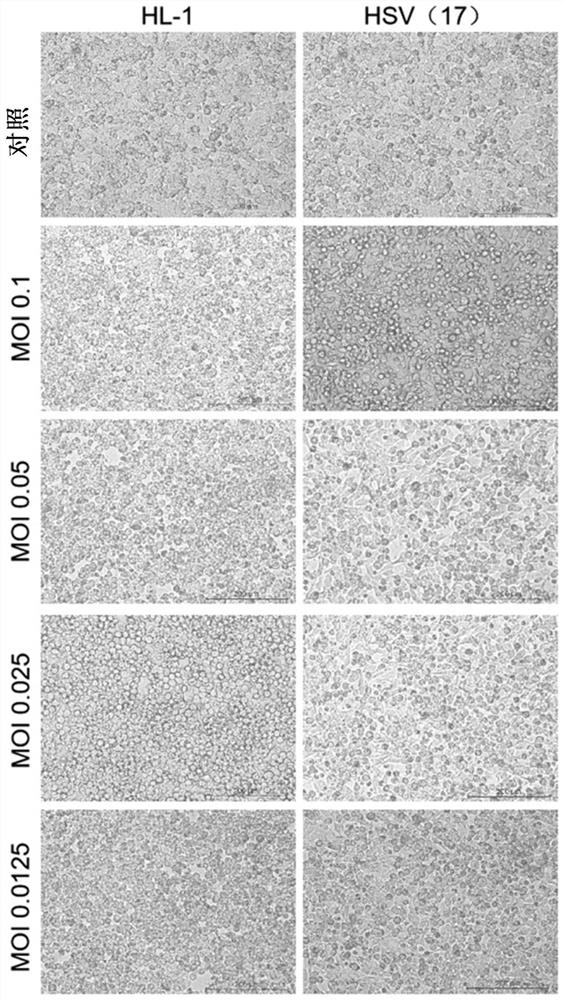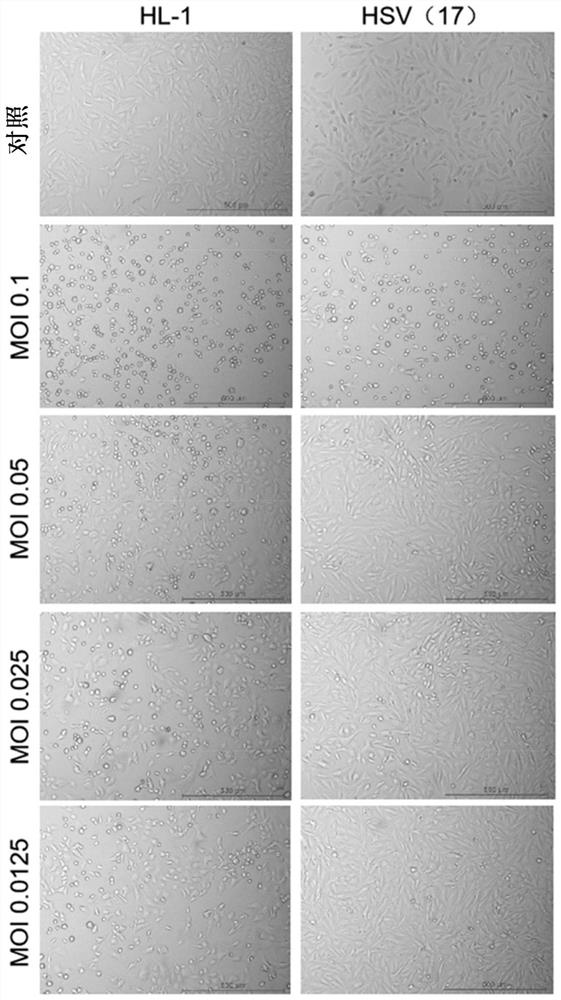Non-reproductive recombinant herpes virus and use thereof
A non-replicating, herpes simplex virus technology, applied in the field of non-replicating recombinant herpes virus, can solve the problems such as transfection and expression of foreign genes need to be improved
- Summary
- Abstract
- Description
- Claims
- Application Information
AI Technical Summary
Problems solved by technology
Method used
Image
Examples
Embodiment 1
[0087] The acquisition of embodiment 1 HL-1 strain virus
[0088] a) Virus collection
[0089] 63 healthy volunteers with recurrent herpes labialis were recruited, and the herpes fluid was aseptically collected.
[0090] b) Virus screening
[0091] The purpose of this section is to test and screen primary clinical isolates of HSV-1 and select the virus strain with the strongest oncolytic ability.
[0092] Experiments were performed simultaneously using 5 to 8 virus strains each time. Using 17 strains of HSV-1 virus as a control, the virus strains were infected with the same MOI in cells in a six-well plate, and the experiments were performed in parallel. After 48 hours of infection, the CPE phenomenon caused by the virus was observed and the number of plaques after crystal violet staining was evaluated. . CPE should be caused by typical HSV-1 infection. The cells become round and gradually fall off from the center of infection to form plaques. Strains with a pronounced CP...
Embodiment 2
[0105] The contrast of embodiment 2 wild HL-1 strains and 17 strains
[0106] This example provides the comparative experiments and results of replication of HL-1 and 17 strains on different cells and their ability to transfect tumor cells. Experimental cells include: Hep G2 human liver cancer cells, A-375 human skin cancer cells, A549 human lung cancer cells, MCF7 human breast cancer cells, HeLa human cervical cancer cells, U251 human glioma cells, and Vero monkey kidney cells.
[0107] The experimental method is as follows:
[0108] 1. HL-1 and HSV(17) were transfected into different cells and observed under microscope
[0109] The above-mentioned cells in the logarithmic growth phase were taken, digested and subcultured into a six-well plate for culture. After 24 hours, the old medium was discarded, and 2ml of medium was added to each well. The transfection was carried out according to the number of viruses at different MOIs. After the virus was added, it was placed in a...
Embodiment 3
[0132] The contrast of embodiment 3 non-replication HSV (HL-1) virus and HSV (17) virus infecting nerve cell ability
[0133] The purpose of this example is to compare the ability of non-replicative HL-1 viruses knocked out of different immediate genes and 17 strains to infect nerve cells, so as to compare the non-replicative HL-1 herpes virus of the present invention as a gene carrier with the standard in the prior art The effect of 17 strains of laboratory virus.
[0134] Construct non-replicative viruses according to methods 1 and 2, respectively, as follows:
[0135] 1. Knock out the ICP34.5 and ICP4 genes of HL-1 strain and 17 strains of HSV virus according to the method of application publication number CN105219739A, and insert an exogenous reporter gene in the LAT region of the virus. From the 5' end to the 3' end, the gene includes: CMV promoter, gene encoding LacZ and BGH PolyA.
[0136] 2. Knock out the ICP34.5 and ICP4 genes of the HL-1 strain and 17 strains of HS...
PUM
| Property | Measurement | Unit |
|---|---|---|
| diameter | aaaaa | aaaaa |
Abstract
Description
Claims
Application Information
 Login to View More
Login to View More - R&D
- Intellectual Property
- Life Sciences
- Materials
- Tech Scout
- Unparalleled Data Quality
- Higher Quality Content
- 60% Fewer Hallucinations
Browse by: Latest US Patents, China's latest patents, Technical Efficacy Thesaurus, Application Domain, Technology Topic, Popular Technical Reports.
© 2025 PatSnap. All rights reserved.Legal|Privacy policy|Modern Slavery Act Transparency Statement|Sitemap|About US| Contact US: help@patsnap.com



